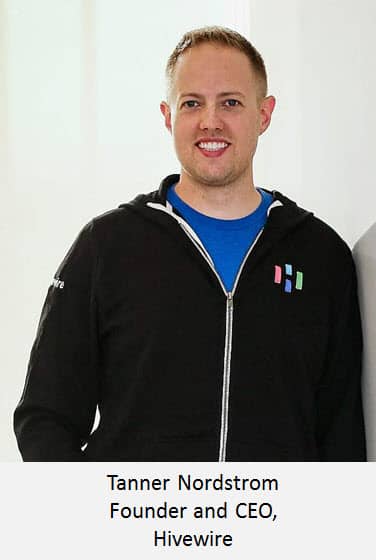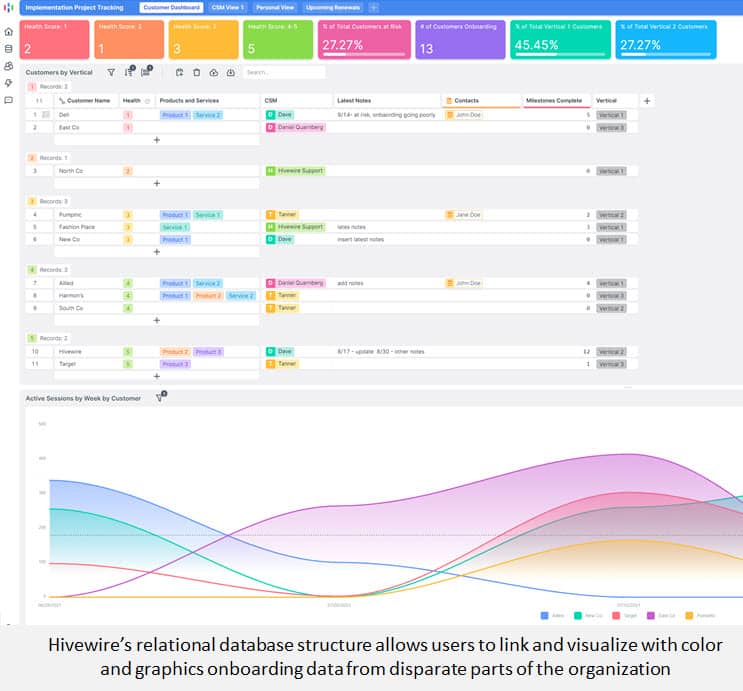

Hivewire, a no-code client onboarding platform startup, announced today it has raised $7.25 million in seed funding. The round was led by Pelion Venture Partners. Participating investors include Peterson Ventures, who led a pre-seed round in fall of 2019 which included Elevation Capital and Village Global. New investors in this seed funding include Signal Peak Ventures and a number of angels including Jeremy Andrus, CEO of Traeger Grills, and executives from Utah tech companies, Qualtrics and Spiff. The company will use the investment to strengthen product development and capitalize on sales momentum.
 "No-code is the future of software," says Tanner Nordstrom, CEO of Hivewire, who co-founded it along with his partners Jacob Shumway (CTO) and Dave Christison (COO, pictured above right). "It's the 'democratization of IT,' bringing on a software revolution and setting a new standard of customer satisfaction. Customers are turning away from herd-mentality, one-size-fits-all, off-the-shelf solutions. Each generation of tech user expects more from the technology they're using. Look at our own consumer experiences and the devices we're using on a daily basis. We're conditioned to want something that looks and feels specific to us. And that mindset is filtering into the tools and platforms we're using to run our businesses."
"No-code is the future of software," says Tanner Nordstrom, CEO of Hivewire, who co-founded it along with his partners Jacob Shumway (CTO) and Dave Christison (COO, pictured above right). "It's the 'democratization of IT,' bringing on a software revolution and setting a new standard of customer satisfaction. Customers are turning away from herd-mentality, one-size-fits-all, off-the-shelf solutions. Each generation of tech user expects more from the technology they're using. Look at our own consumer experiences and the devices we're using on a daily basis. We're conditioned to want something that looks and feels specific to us. And that mindset is filtering into the tools and platforms we're using to run our businesses."
Hivewire focuses on the customer onboarding and product implementation portion of the global customer success platform market, a market forecasted to hit $3.1 billion by 2026, according to the company. Specifically, the company's platform has been designed to improve the critical workflow that sits between customer relationship management (CRM) and traditional customer lifecycle activities such as renewal and upsell planning. Companies are now devoting ample resources to post-sales customer operations, especially the customer onboarding portion of their sale which is critical to reducing customer churn.
The Hivewire platform allows business users to customize and automate customer onboarding processes, resulting in reduced churn through faster onboarding cycles. Hivewire’s relational database structure allows users to link data from disparate parts of their organization and visualize onboarding projects in unique ways. Other capabilities include custom shareable forms, flexible dynamic team or individual views, and a visual workflow builder that empowers teams to automate repetitive but necessary tasks in just a few clicks. Data can be shared both internally between functional groups and externally with customers. Hivewire also integrates with Jira, Slack, email, and customer data platforms like Segment, allowing post-sales teams to augment the value of existing internal tooling.
 Hivewire claims nearly two-thirds of buyers now consider a company’s onboarding process when buying. “Customer onboarding is the most overlooked portion of the customer journey. As a result, customer experience and time-to-value are compromised as teams struggle to manage implementation cycles in spreadsheets, generic task trackers or poorly-customized CRM fields. Other onboarding tools offer prescriptive methods that don’t account for the variations in workflows or the flexibility needed to scale these processes,” says Nordstrom. “For mid-market and emerging enterprises, it’s a recipe for customer failure to rely on these solutions. Hivewire specifically addresses the customer onboarding process for growth and scale-minded customers by empowering teams to organize onboarding and delivery workflows their way with our robust and flexible no-code platform.”
Hivewire claims nearly two-thirds of buyers now consider a company’s onboarding process when buying. “Customer onboarding is the most overlooked portion of the customer journey. As a result, customer experience and time-to-value are compromised as teams struggle to manage implementation cycles in spreadsheets, generic task trackers or poorly-customized CRM fields. Other onboarding tools offer prescriptive methods that don’t account for the variations in workflows or the flexibility needed to scale these processes,” says Nordstrom. “For mid-market and emerging enterprises, it’s a recipe for customer failure to rely on these solutions. Hivewire specifically addresses the customer onboarding process for growth and scale-minded customers by empowering teams to organize onboarding and delivery workflows their way with our robust and flexible no-code platform.”
Nordstrom is seeing a talent gap here in Utah and believes no-code could be a solution. "We have huge demand for unique software solutions that businesses need in order to grow and scale, but we have this incredible gap between talented software engineers and all those open positions. No-code is a big part of bridging that gap; it is key to how businesses will define competitive advantages in the future," says Nordstrom. He continues, "if everyone is using the same solution in the exact same way, the ability to competitively differentiate is diminished. But when you put the right no-code solution in the hands of the operators, it opens up additional opportunities for businesses to run differently than their competitors."
Like most entrepreneurs, Nordstrom and his team put a lot of effort on refining their pitch and deck, but in the end it was the problem they are addressing (post sale workflows, implementation workflows) that got the attention of their investors. "Last July, we set out to raise a seed round, around three million," said Nordstrom. "I told my wife she will likely not see much of me and I will probably be in a bad mood for three to four months during fundraising. Our first pitch was during the first week of July. We had multiple term sheets within three weeks. Pelion really latched on to both our solution and the problem we're addressing right now. We thought they would have one or two people in the room; they brought everyone. They probably don't actually know this, but we went to them as a practice pitch because we knew that they'd give us really hard feedback. We didn't think they'd be interested in our round size, but we wanted the learning experience. Five minutes into the pitch the rest of the meeting was them telling us what a significant problem that is we're resolving. We didn't make it through the rest of the deck. It was a great experience. Working with Pelion and Peterson, quite frankly, has been a dream. We couldn't be happier with our investors," said Nordstrom.
“Hivewire has found a sweet spot in the customer success market, one that has been neglected for far too long by organizations,” says Ben Lambert, General Partner, Pelion Venture Partners. “In talking with some of Hivewire’s earliest customers it was obvious how much value their platform was driving and how customers developed a strong reliance on Hivewire’s capabilities. It’s easy to imagine a future in which Hivewire’s no-code building blocks position it to evolve into a broader enterprise workflow platform that could be a major force in the $45 billion-plus low-code/no-code market.”

